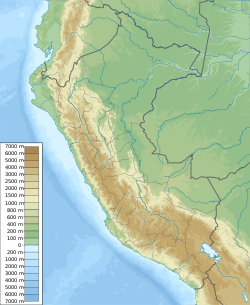Our website is made possible by displaying online advertisements to our visitors.
Please consider supporting us by disabling your ad blocker.
Nazca lines
| UNESCO World Heritage Site | |
|---|---|
 Aerial photograph of one of the Nazca lines, taken in July 2015, that shows the design known as "The monkey" | |
| Location | Southern Peru, South America |
| Criteria | Cultural: I,III,IV |
| Reference | 700 |
| Inscription | 1994 (18th Session) |
| Coordinates | 14°41′51″S 75°8′6″W / 14.69750°S 75.13500°W |
The Nazca lines (/ˈnɑːzkə/, /-kɑː/[1]) are a group of over 700 geoglyphs made in the soil of the Nazca Desert in southern Peru.[2][3] They were created between 500 BC and 500 AD by people making depressions or shallow incisions in the desert floor, removing pebbles and leaving different-colored dirt exposed.[4] There are two major phases of the Nazca lines, Paracas phase, from 400 to 200 BC, and Nazca phase, from 200 BC to 500 AD.[5] In the 21st century, several hundred new figures had been found with the use of drones, and archaeologists believe that there are more to be found.[6][3]
Most lines run straight across the landscape, but there are also figurative designs of animals and plants. The combined length of all the lines is more than 1,300 km (800 mi), and the group covers an area of about 50 km2 (19 sq mi). The lines are typically 10 to 15 cm (4–6 in) deep. They were made by removing the top layer of reddish-brown ferric oxide–coated pebbles to reveal a yellow-grey subsoil.[7][4] The width of the lines varies considerably, but more than half are slightly more than 33 cm (13 in) wide.[2][8] In some places they may be only 30 cm (12 in) wide, and in others reach 1.8 m (6 ft) wide.[2]
Some of the Nazca lines form shapes that are best seen from the air (at around 500 m [1,600 ft]), although they are also visible from the surrounding foothills and other high places.[9][10][11] The shapes are usually made from one continuous line. The largest ones are about 370 m (400 yd) long.[7] Because of its isolation and the dry, windless, stable climate of the plateau, the lines have mostly been preserved naturally. Extremely rare changes in weather may temporarily alter the general designs. As of 2012, the lines are said to have been deteriorating because of an influx of squatters inhabiting the lands.[12][needs update]
The figures vary in complexity. Hundreds are simple lines and geometric shapes; more than 70 are zoomorphic designs, including a hummingbird, arachnid, fish, condor, heron, monkey, lizard, dog, cat, and a human. Other shapes include trees and flowers.[4] Scholars differ in interpreting the purpose of the designs, but in general, they ascribe religious significance to them.[13][14][15][16] They were designated in 1994 as a UNESCO World Heritage Site.
- ^ "Nazca". Collins Dictionary. Archived from the original on 4 May 2024. Retrieved 15 September 2023.
- ^ a b c Sebastian Dorsch; Jutta Vinzent (2017). SpatioTemporalities on the Line: Representations-Practices-Dynamics. Walter de Gruyter GmbH & Co KG. pp. 97–. ISBN 978-3-11-046578-5. Archived from the original on 29 January 2024. Retrieved 19 January 2019.
- ^ a b Collyns, Dan. "Archaeologists use AI to discover 303 unknown geoglyphs near Nazca Lines". The Guardian.
- ^ a b c "Nazca Lines". Guía Go2peru. 22 February 2017. Archived from the original on 29 October 2018. Retrieved 29 October 2018.
- ^ Centre, UNESCO World Heritage. "Lines and Geoglyphs of Nasca and Palpa". UNESCO World Heritage Centre. Archived from the original on 20 February 2022. Retrieved 20 February 2022.
- ^ Jones, Sam (18 October 2020). "Huge cat found etched into desert among Nazca Lines in Peru". the Guardian. Archived from the original on 26 March 2021. Retrieved 26 March 2021.
- ^ a b Glomb, Jason (8 November 2010). "Nasca Lines". National Geographic. Archived from the original on 28 September 2019.
- ^ Anthony F. Aveni (1990). The Lines of Nazca. American Philosophical Society. ISBN 9780871691835. Archived from the original on 4 May 2024. Retrieved 19 January 2019.
- ^ Gardner's Art Through the Ages: Ancient, medieval, and non-European art Archived 4 May 2024 at the Wayback Machine. Harcourt Brace Jovanovich; 1991. ISBN 978-0-15-503770-0.
- ^ Hinman, Bonnie (2016).Mystery of the Nazca Lines Archived 4 May 2024 at the Wayback Machine. ABDO; ISBN 978-1-68077-242-5. pp. 6–.
- ^ Anthony F. Aveni (2000). Between the Lines: The Mystery of the Giant Ground Drawings of Ancient Nasca, Peru. University of Texas Press. ISBN 978-0-292-70496-1. pp. 88–.
- ^ Taj, Mitra (15 August 2012). "Pigs and squatters threaten Peru's Nazca lines". Reuters. Archived from the original on 20 December 2019. Retrieved 15 August 2012.
- ^ Helaine Selin (2013). Nature Across Cultures: Views of Nature and the Environment in Non-Western Cultures. Springer Science & Business Media; ISBN 978-94-017-0149-5. pp. 286–.
- ^ Richard A. Freund (2016). Digging Through History: Archaeology and Religion from Atlantis to the Holocaust. Rowman & Littlefield. ISBN 978-1-4422-0883-4. pp. 22–.
- ^ Mary Strong (2012). Art, Nature, and Religion in the Central Andes: Themes and Variations from Prehistory to the Present. University of Texas Press. ISBN 978-0-292-73571-2. pp. 33–.
- ^ Religion and the Environment. Palgrave Macmillan UK; 2016. ISBN 978-0-230-28634-4. pp. 110–.
Previous Page Next Page



